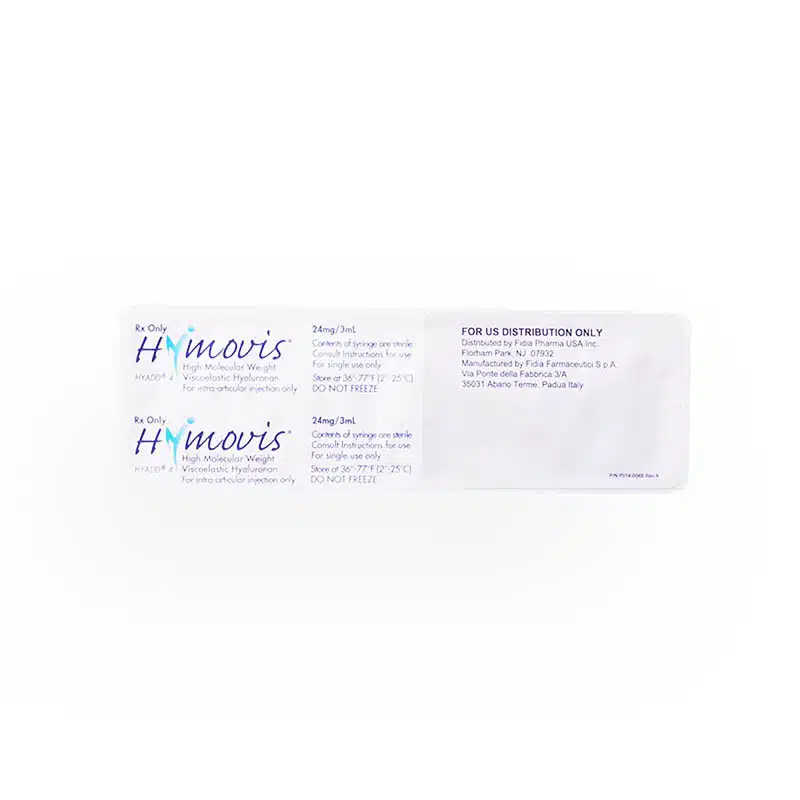Viscosupplementation is a treatment for osteoarthritis that involves injecting hyaluronic acid directly into the joint to help it move more smoothly and reduce pain. Studies show that these injections can provide significant relief and even delay the need for more invasive procedures like joint replacements, giving patients a better quality of life over time.
Two popular options for this treatment are Hymovis and Synvisc. While both aim to ease joint pain, they differ in things like their formula, dosage, and how often they’re given. Understanding these differences can help patients and doctors decide which option might be the best fit.
In this article, we’ll compare Hymovis vs Synvisc, looking at their benefits, side effects, and how well they work to help you make an informed choice.
Key Takeaways
- Both Hymovis and Synvisc are effective treatments for reducing knee pain caused by osteoarthritis, though they work slightly differently.
- Hymovis tends to provide longer-lasting relief, with many patients experiencing benefits for up to six months or more after just two injections.
- Synvisc also offers relief that can last around six months, but it may require more frequent treatments, typically involving three injections, though a single-dose option (Synvisc-One) is available.
- Common side effects for both treatments include temporary pain, swelling, and stiffness at the injection site, which usually resolve on their own.
- Choosing between Hymovis and Synvisc often comes down to personal preference, cost, and the convenience of the treatment protocol.
About: Medical Spa RX provides medical practices with premium products at the best prices. If you’re looking to buy Hymovis for your practice, the sales representatives at Medical Spa RX can give you guidance.
Understanding Viscosupplementation Treatments for Osteoarthritis
Viscosupplementation is a treatment for knee osteoarthritis that injects gel-like substances, mainly made from hyaluronic acid, directly into the joint. Hyaluronic acid is a natural lubricant that helps joints move smoothly and absorb shock. By increasing the amount of this fluid in the knee, viscosupplementation can reduce pain and make it easier for people to stay active.
For many patients, viscosupplementation is an important option when other treatments, like physical therapy or pain medications, aren’t enough. It offers a way to manage pain without immediately resorting to surgery, often delaying the need for joint replacement and helping people maintain their quality of life.
Among the most popular viscosupplements are Hymovis and Synvisc. Both are injected into the knee to relieve osteoarthritis pain but have some key differences.
Molecular Composition and Mechanism of Action
- Hymovis: Hymovis is made from a special type of hyaluronic acid modified to last longer in the knee joint. This gives it a thicker, more flexible consistency, allowing it to cushion the joint and reduce pain over time. Its unique structure helps it stay in the joint longer, providing extended relief from osteoarthritis symptoms.
- Synvisc: Synvisc is a gel-like substance made from a natural ingredient found in chicken combs. It mimics the fluid that naturally lubricates the knee, helping the joint move more smoothly and absorb shock. By acting as a lubricant and cushion, Synvisc helps ease pain and improve mobility in people with osteoarthritis.
Efficacy and Treatment Protocols
Both Hymovis and Synvisc are effective treatments for managing osteoarthritis symptoms, but they differ slightly in how long the relief lasts and how the treatments are administered.
Hymovis is known for providing long-lasting pain relief. Many patients start to feel improvement in their pain and movement within a few weeks, and the effects can last up to six months or even longer. Its unique formula stays in the joint longer, often requiring fewer injections.
Synvisc is also effective, helping reduce pain and improve joint function. Like Hymovis, it generally takes a few weeks to notice the full effects and the relief can last around six months. However, some people may find they need more frequent injections to maintain their results compared to Hymovis.
When it comes to treatment protocols, Hymovis typically requires just two injections, spaced about a week apart, making it a convenient choice for patients who prefer fewer doctor visits. Synvisc, on the other hand, usually involves three injections given one week apart. However, there’s also a version called Synvisc-One, which is a single-dose injection that can offer similar results.
Side Effects, Patient Outcomes, and Duration of Symptom Relief
Both Hymovis and Synvisc are generally well-tolerated treatments for osteoarthritis, but like any medical procedure, they can come with some side effects.
For Hymovis, the most common side effects include localized pain, swelling, or stiffness around the injection site. These Hymovis side effects are usually mild and tend to resolve within a few days after treatment.
Synvisc shares similar side effects, such as temporary pain or swelling in the knee after the injection. In rare cases, some people might experience allergic reactions or more serious symptoms like joint infections, though these are uncommon with either treatment.
Patient Outcomes with Hymovis and Synvisc Treatment
Hymovis patients often notice significant improvements in their pain levels and joint mobility within a few weeks, with the effects continuing for several months. Synvisc also provides relief, helping patients move more comfortably and experience less pain. While both treatments aim to improve the quality of life, individual experiences can vary based on the severity of osteoarthritis and the patient’s overall health.
Duration of Symptom Relief with Hymovis and Synvisc
Hymovis and Synvisc offer respite but cannot repair cartilage or heal bones. Their shared aim is to mitigate pain temporarily. With Hymovis, many patients report relief lasting up to six months or longer, thanks to its long-lasting formulation. Synvisc provides similar relief, typically lasting about six months as well, though some patients might need additional treatments to maintain the same level of comfort.
Conclusion
Both Hymovis and Synvisc can help ease knee pain from osteoarthritis by providing much-needed relief and improving how the joint moves. Studies show that they’re both pretty effective at reducing pain, but neither will fully fix the underlying problem.
In the end, deciding between the two often comes down to practical things like how many injections you’re comfortable with, the cost, or what’s more convenient for your lifestyle. It’s really about finding what works best for you and your specific needs.
FAQs
1. What are the common side effects of Hymovis and Synvisc?
Both treatments can cause mild side effects like pain, swelling, or stiffness around the injection site. These symptoms are usually temporary and go away after a few days.
2. How long does the relief from Hymovis or Synvisc last?
Relief from both treatments typically lasts around six months. However, Hymovis may offer slightly longer-lasting results for some patients, while Synvisc may require more frequent injections.
3. How many injections do I need for Hymovis or Synvisc?
Hymovis usually requires just two injections spaced a week apart. Synvisc typically requires three injections given a week apart, but there is also a single-dose version called Synvisc-One.
4. Can these treatments cure osteoarthritis?
Neither Hymovis nor Synvisc cures osteoarthritis. They help manage the symptoms, reduce pain, and improve joint function, but they do not reverse the underlying condition.
References
Viscosupplementation for knee arthritis. American Academy of Orthopaedic Surgeons. https://orthoinfo.aaos.org/en/treatment/viscosupplementation-treatment-for-knee-arthritis/
Crockett, Z., Asikhia, O., Rhim, H., & others. (2024). Injection-based therapies for knee osteoarthritis: A comprehensive update. Current Physical Medicine and Rehabilitation Reports, 12(4), 256–265. https://doi.org/10.1007/s40141-024-00458-2
Migliore, A., Frediani, B., Gigliucci, G., Foti, C., Crimaldi, S., De Lucia, O., & Iolascon, G. (2020). Efficacy of a Single Intra-Articular HYMOVIS ONE Injection for Managing Symptomatic Hip Osteoarthritis: A 12-Month Follow-Up Retrospective Analysis of the ANTIAGE Register Data. Orthopedic research and reviews, 12, 19–26. https://doi.org/10.2147/ORR.S239355






















